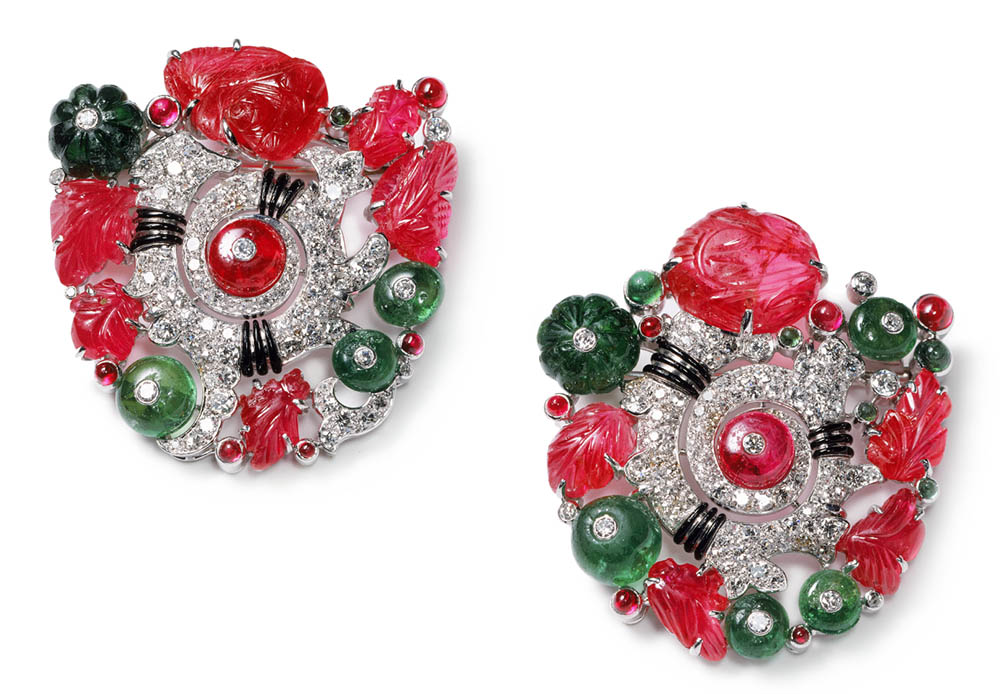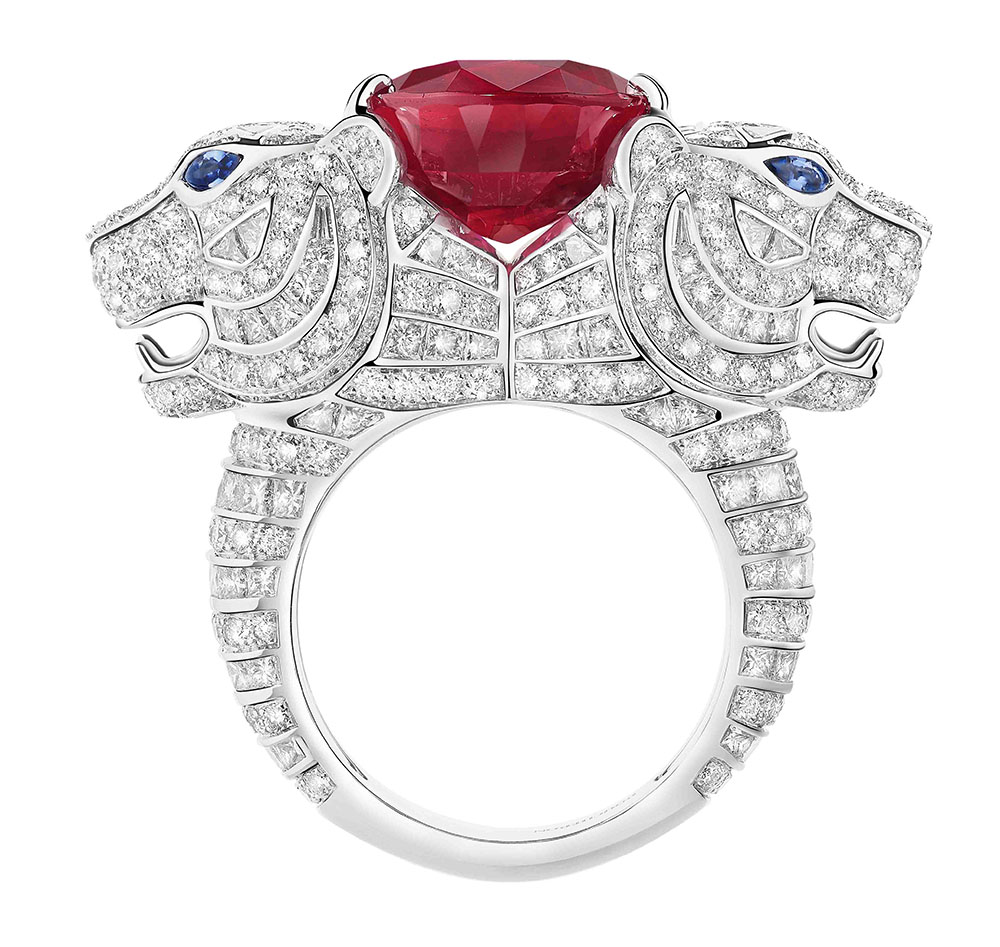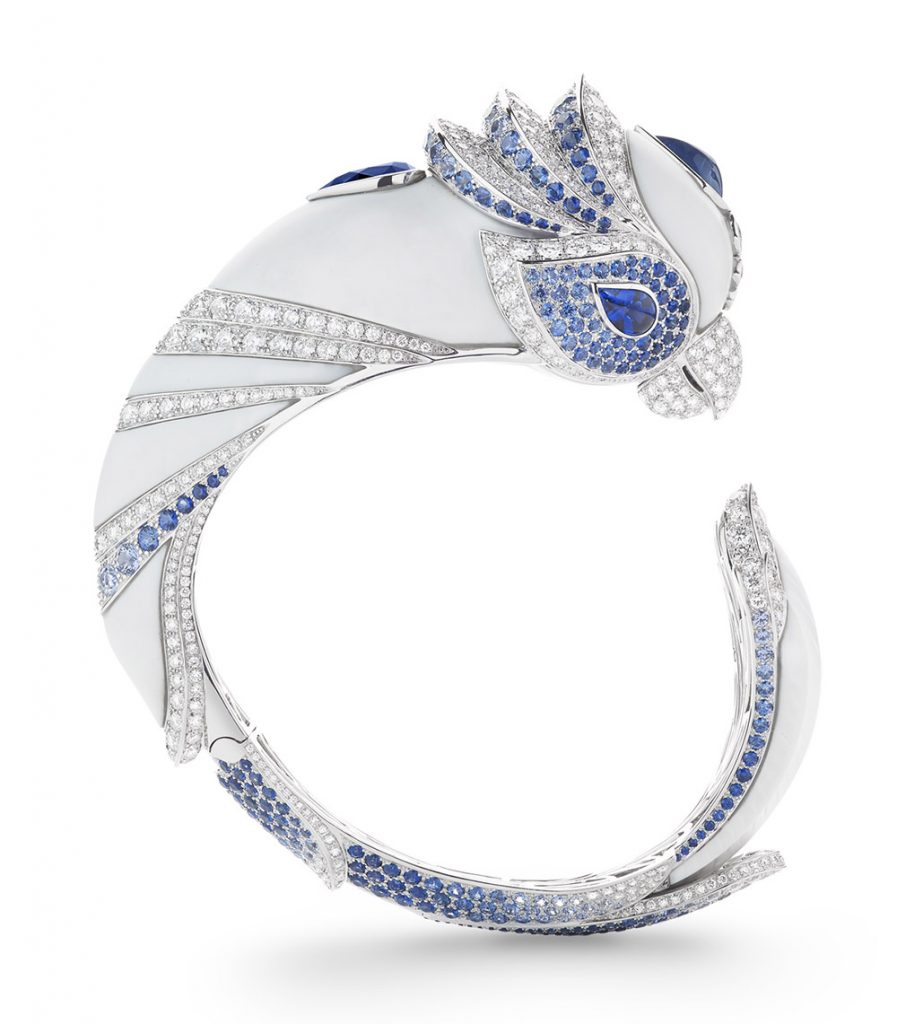India’s maharajas add glittering history to refurbished Place Vendome, the epicentre of the French high-jewellery world.
Place Vendome, the epicentre of the French high-jewellery world, has recently undergone a multi-billion-euro makeover that has restored its elegant facades into objects of beauty. Adorned in sparkling Christmas trees for the holiday season, these exteriors all but match the exquisite jewellery that is handmade in France and sold inside its luxury boutiques.
Where tourists now potter about, taking photographs of these beautiful structures, the Maharajas once came with trunks of gemstones to be fashioned by the high jewellery houses in residence on the square. They were welcomed into beautiful salons kept under wraps, like its jewels, for select clients. Today, too, high-end industrialists from India shop here for luxury pieces.
The results of this two-way attraction include some stand-out jewellery designs like Cartier’s Tutti Frutti collection with its maharaja necklace, which was worn by celebrities from Ms. Cole Porter to Lady Mountbatten.
“It was a great wave of cross pollination for Indian gemstones, with Indian styles redesigned by the West, and according to their senses, what they perceive India to be,” says Tarang Arora, CEO and Creative Designer at Amrapali Jewels in Jaipur. “It really changed how Western jewellery design for Indians started, and we can see it emerging a lot more again today. A movement of an Indian aesthetic but in a very contemporary international way is becoming more and more important.”
Fabulous tales and photographs of India’s maharajas adorn the walls of historic jewellery houses, like Boucheron, which had a strong relationship with India’s elite from the beginning.
Boucheron, Chaumet, Dior, Chanel, and Cartier are among those that call Place Vendome home today, not to mention fashion houses like Schiaparelli and The Ritz where some of this Indian royalty would stay.
“Place Vendôme and the boutiques of the great jewellery firms symbolise French jewellery and the French ‘savoir-faire’ because all the jewels sold there are made in workshops in Paris or in France,” explains Évelyne Possémé, Chief Curator of Ancient and Modern jewellery at the Musée des Arts Décoratifs, Paris. The museum is currently exhibiting some of this history in its “Cartier and Islam,” exhibition which shows how Cartier courted the Maharajas to do business with his house in the 1910s.
“Jacques Cartier was in India for the Durbar of the King and the Queen of England in December 1911, so he could meet all the Maharajas in Delhi. The Maharajas came to Paris and London after the First World War, in the Art Deco period,” adds Posseme. “At the same time, in the 1920-1930, the maharajas were also clients of Boucheron and the Van Cleef & Arpels firm.”
Jewellery historians note that this interaction began before. “The Maharajas started travelling to England and Europe in the late 19th century, while European jewel merchants and gem dealers were already visiting India from as early as the 16th century, much before Cartier’s arrival in India,” says Dr. Usha R Balakrishnan, the leading Indian jewellery historian and curator.
At Les Arts Décoratifs, some pieces from the Cartier period can be seen currently. Others were on display as early as the late 19th century, she notes.
“Interestingly, the renowned Parisian jeweller Oscar Massin executed a magnificent commission, a diamond studded belt, for Mir Mahboob Ali Khan, the sixth Nizam of Hyderabad with gemstones supplied by the Nizam. The belt was exhibited in the Paris Exposition of 1878,” adds Balakrishnan.
Cartier’s fascination with India was broad. “Prompted by Europe’s fascination with the Orient and the International exhibitions held in Paris and London, jewellers ventured to India, where there was a lucrative market for watches, gems and jewels,” says Balakrishnan. “Cartier’s exploration was not confined to Islamic design, but to Indian design architecture, motifs, colour palette and, importantly, fabulous Indian gemstones. The maharajas succumbed to the lure of avant-garde designs, Art Deco forms, the muted elegance of platinum, French design sensibility and modern settings.”
On Place Vendome, the Maharajas were entertained in some of the exquisite secret salons above the shop floors. At Boucheron, panels of historic photographs attest to this history. Staff keep the maharaja stories alive by sharing tales of them arriving with trunks of stones with journalists and visiting guests.
“The maharajas were taking that leap to going to international jewellers and design houses at Place Vendome, and also opening up their wealth, their gemstones and diamond treasures,” says Arora. “It was like Pandora’s box. When one maharaja went, followed by the second and the third, others, too, got more and more confident in giving these top French jewellers bespoke commissions. To this day, I have clients that are big industrialists and travellers and they wish to buy a piece from Place Vendome.”
The refashioning of these gemstones was and still is discussed inside some of these resplendent salons. Several of these boutiques, including Boucheron, Chumet, and Chanel, have been undergoing restoration, making these interiors even more beautiful.
Chaumet’s Salle Chopin, and its surrounding rooms, have been repainted in exquisite Chaumet blue, making its museum of tiaras, reserved for special guests, sparkle all the more brightly. Chaumet’s storied rooms include the Salon des Joyaux. Here high jewellery pieces are presented, and special orders are designed with its in-house team.
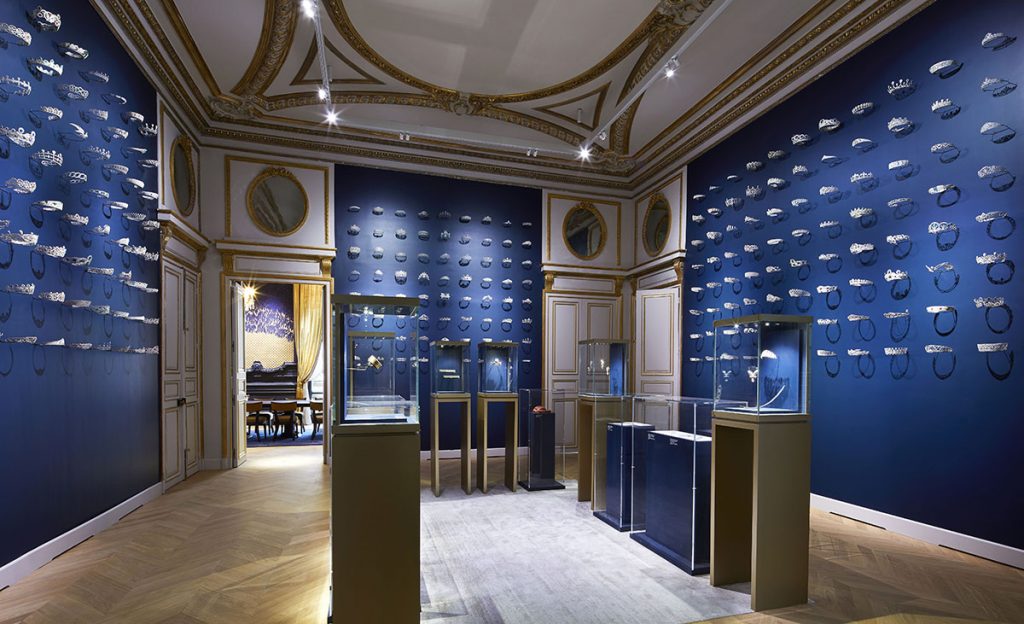
“In natural shades or tinted Chaumet blue, the straw marquetry radiating across the walls was created especially for the Maison by the Jallu Straw workshop,” according to a press note by the house.
The Salon Chopin is classified as an historic monument. In 1779, artisans favoured by King Louis XVI and Marie-Antoinette gave it its resplendent look.
In the Salon des Diadèmes hundreds of tiaras are displayed, and many crafted in nickel silver are displayed against a blue background.
At Boucheron, India is intertwined into many of its collections. Two examples are the Bleu de Jodhpur and Art Deco high jewellery collections. The Bleu de Jodhpur collection is a romantic interpretation of the Blue City with Art Deco inspired features. The collection was the result of a collaboration between Boucheron’s creative director Claire Choisne and the Maharaja of Jodhpur.
“Following his Majesty’s wishes, the high jewellery collection comprises an array of unorthodox materials, such as sand and marble that are blended in style with pearls, diamonds and sapphires for the ultimate celebration of flamboyance and luxurious indulgence,” the Boucheron house noted.
The Art Deco collection features a necklace that connects Boucheron’s historical ties with India. The emerald, diamond and onyx necklace inspired by the house was created for the Maharaja of Patalia in 1928. Featuring 220 emerald beads weighing an incredible 1,071.97 carats, the necklace was based on an archival image of the Maharaja’s commission. The design is the largest special order created by Boucheron for the Indian royal.
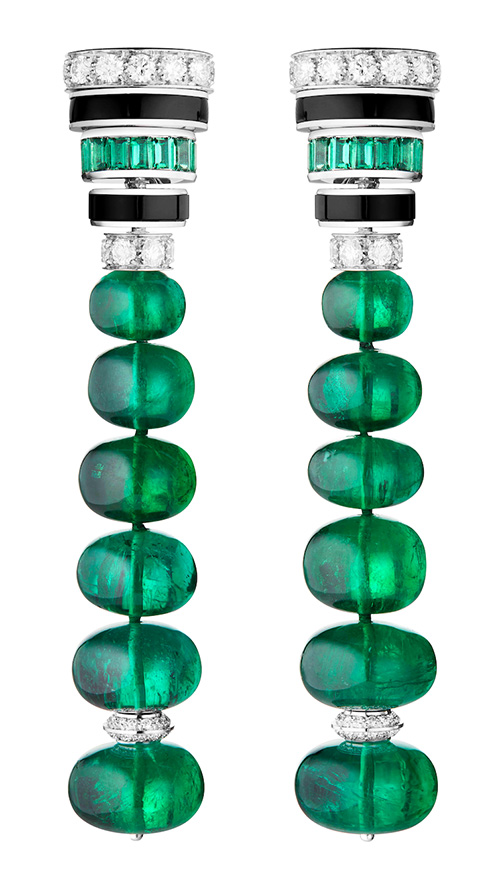
“The Maharaja was in the Ritz just near Boucheron and he went through the Place Vendome with six Sikh guards carrying cases of stones and we designed 149 pieces for him,” says Choisne. “They were huge pieces full of emeralds, diamonds and tourmalines. They were really spectacular.”
The Maharajas were patrons of Chaumet, Mauboussin, Van Cleef & Arpels, Mellerio, and Boucheron. They all produced fabulous items for their royal clients, notes one auction house.
The first to open a boutique at 12 Place Vendome was Chaumet. Boucheron opened their boutique in 1858 and Cartier France’s headquarter was established at 13 Rue de la Paix, just off Place Vendome in 1899. JAR established his atelier at Place Vendome Nr 7, l’Hotel le Bas de Montargis in the late 1970s.
“Boucheron was the first address for the Maharajas in the 1920s when they came to Place Vendome. They were looking to reset their jewels into more modern designs of the time,” added the spokesperson from an auction house speaking anonymously. “Cartier played a big role when in 1928 the house reset the Maharaja of Patiala’s jewels. And obviously their multiple visits to India played a role too.”
“The Tutti Frutti design by Cartier is certainly a benefit from the Maharajas bringing their gemstones to Paris, which were cut in such different ways to the European stones and a new design had to be created to use these stones to underline their beauty and rarity,” she adds.
The tradition continues. “Magnificent gemstones from India, formerly in the collection of the Maharajas and noblemen, still find their way to jewellers at Place Vendome,” notes Balakrishnan. “Jacques Cartier travelled to India in 1911 to attend the Delhi Durbar, a grand event that was held to mark the accession of King George V of England as Emperor of India. It was Cartier’s first encounter with the Maharajas, an encounter that was to develop into an extremely deep relationship across the leading courts of India resulting in the production of magnificent jewels to this day.”
Squared off
The history of the square itself spans Louis, the Sun King to the French Revolution. The square’s name was taken from a royal love child, the Duke of Vendôme, who owned a building that once stood on the site of the square.
The duke was the offspring of a French beauty, Gabrielle d’Estrée, who was known as the ‘blond Venus’ and the ‘almost queen’, and King Henri IV.
Louis XIV abandoned plans to transform the square to focus on Versailles. The unfinished square was offered to the city of Paris instead. Key scenes in the French Revolution took place here. A bust of Necker, a French minister who was detested, was smashed at the foot of a statue of Louis XIV on the square. Now atop the column from 1810 that is the focal point of the square, it’s Napoleon’s bust that presides over the coming and goings at the heart of French luxury.


